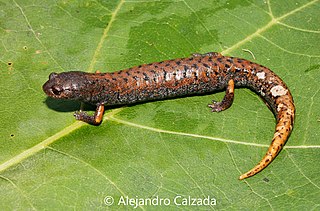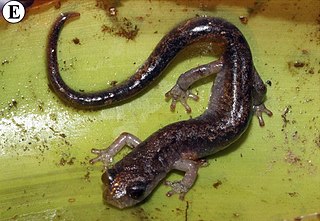
Chiropterotriton, also known as splayfoot salamanders or flat-footed salamanders, is a genus of salamanders in the family Plethodontidae. The genus is endemic to Mexico.

Pseudoeurycea is a genus of salamander in the family Plethodontidae. The members of this genus are commonly known as the false brook salamanders. They are found in Mexico and Guatemala.

Pseudoeurycea aurantia, commonly known as Peña Verde salamander, is a species of salamander in the family Plethodontidae. It is endemic to Oaxaca, Mexico and only known from its type locality near Peña Verde, which is the northernmost high peak in the Sierra de Juárez.

Aquiloeurycea cephalica is a species of salamander in the family Plethodontidae. It is endemic to central Mexico. It is a species complex.

Aquiloeurycea galeanae, commonly known as the Galeana false brook salamander, is a species of salamander in the family Plethodontidae. It is endemic to north-eastern Mexico and known from higher elevations in the Sierra Madre Oriental of southern Nuevo León as well as adjacent Coahuila and Tamaulipas.

Pseudoeurycea juarezi is a species of salamander in the family Plethodontidae, endemic to Mexico.

Pseudoeurycea lynchi, commonly known as the Veracruz green salamander, is a species of salamanders in the family Plethodontidae. It is endemic to the central Sierra Madre Oriental in Veracruz and Puebla states, Mexico.
Isthmura naucampatepetl, commonly known as the Cofre de Perote salamander, is a species of salamanders in the family Plethodontidae. It is endemic to the Sierra Madre Oriental in central Veracruz, Mexico, where it is known from between Cofre de Perote and Cerro Volcancillo, a satellite peak of Cofre de Perote.
The ridge tail salamander, also known as ridge-tailed salamander is a species of salamander in the family Plethodontidae. It is endemic to Oaxaca, Mexico, and only known from the area of its type locality on the mountain pass of Plan de Guadalupe in the Sierra de Mazateca, part of the Sierra Madre de Oaxaca, at 2,150 meters elevation. Future work might prove it to be more widespread than current records suggest. Its extent of occurrence is 10 km2.
Aquiloeurycea praecellens, also known as the admirable false brook salamander, is a species of salamander in the family Plethodontidae. It is endemic to the Sierra Madre Oriental in Veracruz, Mexico. Its natural habitat is lowland tropical moist forest where it is threatened by habitat loss.
The Cuetzalan salamander is a species of salamander in the family Plethodontidae. It is endemic to the Sierra Madre Oriental in Puebla, Mexico. Its specific name refers to its type locality, Cuetzalan del Progreso. Its natural habitat is cloud forest, but it also occurs in coffee groves. It has been found in a range of micro-habitats, such as under moss in rock walls, under stones, inside and under rotten logs, and in leaf axils. It might be threatened by habitat loss caused by human settlements and tourist development.

Pseudoeurycea ruficauda, also known as the orange-tailed agile salamander, is a species of salamander in the family Plethodontidae. It is endemic to the Sierra Mazateca, a part of Sierra Madre de Oaxaca of Mexico. The specific name ruficauda derives from the Latin words rufous (=reddish) and cauda (=tail) and refers to the reddish orange tail of this salamander. P. jaguar is its closest relative.

Aquiloeurycea scandens, commonly known as the Tamaulipan false brook salamander, is a species of salamander in the family Plethodontidae. It is endemic to Mexico and known from the El Cielo Biosphere Reserve in southern Tamaulipas. There are also reports from San Luis Potosí and Coahuila, but these may well refer to other, as yet unnamed species.
Pseudoeurycea unguidentis is a species of salamander in the family Plethodontidae. It is endemic to northern Oaxaca, Mexico, where it is known from its type locality, Cerro San Felipe in the Sierra Madre de Oaxaca, and some other mountains, although the identity of animals from these other locations is uncertain. Its common names are claw-toothed salamander, clawtooth false brook salamander, and clawtoed false brook salamander.
Thorius arboreus, commonly known as the arboreal minute salamander, is a species of salamander in the family Plethodontidae. It is endemic to Sierra de Juarez, Oaxaca, Mexico. The specific name arboreus, derives from the Latin word arbor, meaning tree, referring to the arboreal habitat of this species.
Thorius, also known as minute salamanders, pigmy salamanders, or Mexican pigmy salamanders, is a genus of salamanders in the family Plethodontidae. They are endemic to Mexico and found in southern Veracruz and Puebla to Guerrero and Oaxaca.

The Chinanteca salamander is a species of salamander in the family Plethodontidae. It is endemic to Sierra Juárez, Oaxaca, Mexico. Its sister taxon is Bolitoglossa occidentalis.

The El Cielo Biosphere Reserve is located in the Sierra Madre Oriental in the southern part of the Mexican state of Tamaulipas near the town of Gómez Farias. The reserve protects the northernmost extension of tropical forest and cloud forest in Mexico. It has an area of 144,530 hectares made up mostly of steep mountains rising from about 200 metres (660 ft) to a maximum altitude of more than 2,300 metres (7,500 ft).

Isthmura is a genus of salamanders in the family Plethodontidae. They are endemic to Mexico. The genus, which corresponds to the former "Pseudoeurycea bellii species group" and was first described as a subgenus of Pseudoeurycea, was raised to full generic level in 2015 in order to preserve Ixalotriton and Bolitoglossa while avoiding paraphyly of Pseudoeurycea.

Pseudoeurycea jaguar, or the jaguar salamander, is a species of salamander in the family Plethodontidae. It is endemic to Veracruz, Mexico.
















